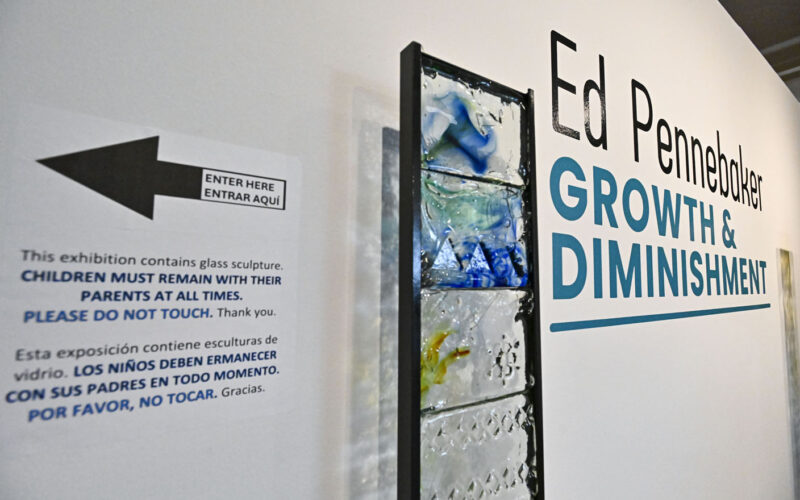“Growth and Diminishment” exhibit at the Fort Smith Regional Art Museum explores life cycle and environmental change

Dustin Staggs
NWA Democrat-Gazette
Walking into the “Growth and Diminishment” exhibition at the Fort Smith Regional Art Museum (RAM) is like entering a complex dance between natural elements and industrial components, with glass sculptures twisting and coiling to capture nature’s dynamic forces.
Multiple large glass chandeliers illuminated from their core all the way to their swirling points hang from the ceiling. While every piece says do not touch, it’s hard to fight the urge to want to feel every different texture that makes up the various integrants in the room.
Ed Pennebaker, an artist who resides in Clinton, created the works of art that premiered on Aug. 31 and will be on display until Jan. 19. The exhibit depicts the cycle of life through a vibrant interplay of glass, metal, stone and miscellaneous materials.
“Environmental concerns have been a theme in my work,” Pennebaker stated in his description of the pieces. “I see the forms in the chandeliers as growing, moving, organic pieces. The name for the wavy forms is ‘ensiform’ which is a horticultural term for plant leaves that are blade or sword-like.”
This phrase is critical to understanding the reoccurring themes in his exhibition, which range from early pieces inspired by seed heads and flowers to later sculptures reflecting seismic activity, fracking, climate change and the unpredictable COVID-19 pandemic. For Pennebaker, “Growth and Diminishment” represents the endless life cycle, with each sculpture representing birth, development, blossoming, reproduction, declining, death and decay.
For almost four decades, Pennebaker’s intimate affinity for nature and environmental issues has served as a foundation for his artistic career, according to his website.
“Where I lived in Osage, I lived out in the woods and did a lot of walking in the woods, and was interested in just watching things and where things grew,” he said.
His interest in nature is obvious in the organic forms of his glass work, many of which appear to swing like blades of grass caught in a breeze or flowers blooming in slow motion. With Pennebaker’s background of experimenting with several glass processes, including flame working, hot casing, cold working and fusing, he was able to realize he could depict the tension between fragility and durability. Pennebaker said he considers glass as a really fluid medium and that it relates with nature very well, because of the movement and fluidity of natural forms.
According to Gallery Manager Casey Seamans, one series in the show, the “Chaos” series, came to be after the super tornado outbreak in 2008, which cut a 122-mile route through Arkansas, affecting cities from Clinton to Highland. Pennebaker used storm debris and metal scraps on his own land to create sculptures that reflect nature’s chaotic and destructive force, as well as the human effect on the environment. Pennebaker sees this series as a conversation with nature relating to the troubled times of climate change and the political divisiveness associated with them.
Pennebaker’s reaction to the events of COVID was to make work he’d never made before, said Seamans. This resulted in his “Variations and Mutations” series. Pennebaker developed pieces that reflect the unpredictability and variability of viral mutations by using a glass called Caledonia, which generates varied hues based on tiny changes in its chemical makeup.
The exhibit’s gallery structure reinforces the story of development and decline, with each part reflecting a distinct stage of life or environmental effect. Visitors can expect to be led on a trip that depicts the volatility and resilience of the natural world, with sculptures imitating budding seed pods and pieces expressing chaos and disintegration.
Through Jan. 19, visitors are able to walk through the exhibit at RAM, surrounded by glittering glass and textured metal, being reminded that art, like nature, may grow, blossom, wither and survive. Pennebaker’s “Growth and Diminishment” challenges viewers to consider our relationship with the environment and to see beauty not just in creation but also in the inevitable transitions that follow.
—
FAQ
“Growth and Diminishment”
WHEN — Exhibit is up until Jan. 19. Museum hours are 11 a.m.-5 p.m. Tuesday-Saturday and 1-5 p.m. on Sunday.
WHERE — Regional Art Museum, 1601 Rogers Ave., Fort Smith
COST — Free
INFO — fsram.org


